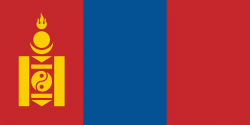Baruunturuun
Baruunturuun (Баруунтуруун) is a sum in Uvs Province of Mongolia.
It is the heartland of grain production in the province, and lies on the bank of the Turuun River. The sum is also one of the most populous areas in the province. MIAT Mongolian Airlines flew to Baruunturuun directly from Ulan Bator until 2005, but stopped due to a plane shortage. Although the Baruunturuun Airport is not operational at the moment, it is considered the secondary airport of the province.
Baruunturuun has a continental climate (Köppen climate classification Dwb) closely bordering on a subarctic climate (Köppen climate classification Dwc) with warm summers and bitterly cold winters even for Mongolia, owing to very strong altitudinal temperature inversions from drainage of cold air into the western valleys. The average minimum temperature in January is -36.3 °C, and temperatures as low as -49.9 °C have been recorded. Temperatures in summer can be hot; the maximum temperature recorded is 39.2 °C. Much precipitation falls in the summer as rain, with some snow in the spring and autumn. Winters are quite dry, with only light snowfall.
It is the heartland of grain production in the province, and lies on the bank of the Turuun River. The sum is also one of the most populous areas in the province. MIAT Mongolian Airlines flew to Baruunturuun directly from Ulan Bator until 2005, but stopped due to a plane shortage. Although the Baruunturuun Airport is not operational at the moment, it is considered the secondary airport of the province.
Baruunturuun has a continental climate (Köppen climate classification Dwb) closely bordering on a subarctic climate (Köppen climate classification Dwc) with warm summers and bitterly cold winters even for Mongolia, owing to very strong altitudinal temperature inversions from drainage of cold air into the western valleys. The average minimum temperature in January is -36.3 °C, and temperatures as low as -49.9 °C have been recorded. Temperatures in summer can be hot; the maximum temperature recorded is 39.2 °C. Much precipitation falls in the summer as rain, with some snow in the spring and autumn. Winters are quite dry, with only light snowfall.
Map - Baruunturuun
Map
Country - Mongolia
 |
|
| Flag of Mongolia | |
The territory of modern-day Mongolia has been ruled by various nomadic empires, including the Xiongnu, the Xianbei, the Rouran, the First Turkic Khaganate, and others. In 1206, Genghis Khan founded the Mongol Empire, which became the largest contiguous land empire in history. His grandson Kublai Khan conquered China proper and established the Yuan dynasty. After the collapse of the Yuan, the Mongols retreated to Mongolia and resumed their earlier pattern of factional conflict, except during the era of Dayan Khan and Tumen Zasagt Khan. In the 16th century, Tibetan Buddhism spread to Mongolia, being further led by the Manchu-founded Qing dynasty, which absorbed the country in the 17th century. By the early 20th century, almost one-third of the adult male population were Buddhist monks. After the collapse of the Qing dynasty in 1911, Mongolia declared independence, and achieved actual independence from the Republic of China in 1921. Shortly thereafter, the country became a satellite state of the Soviet Union, which had aided its independence from China. In 1924, the Mongolian People's Republic was founded as a socialist state. After the anti-communist revolutions of 1989, Mongolia conducted its own peaceful democratic revolution in early 1990. This led to a multi-party system, a new constitution of 1992, and transition to a market economy.
Currency / Language
| ISO | Currency | Symbol | Significant figures |
|---|---|---|---|
| MNT | Mongolian tögrög | ₮ | 2 |
| ISO | Language |
|---|---|
| MN | Mongolian language |
| RU | Russian language |















